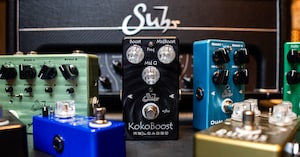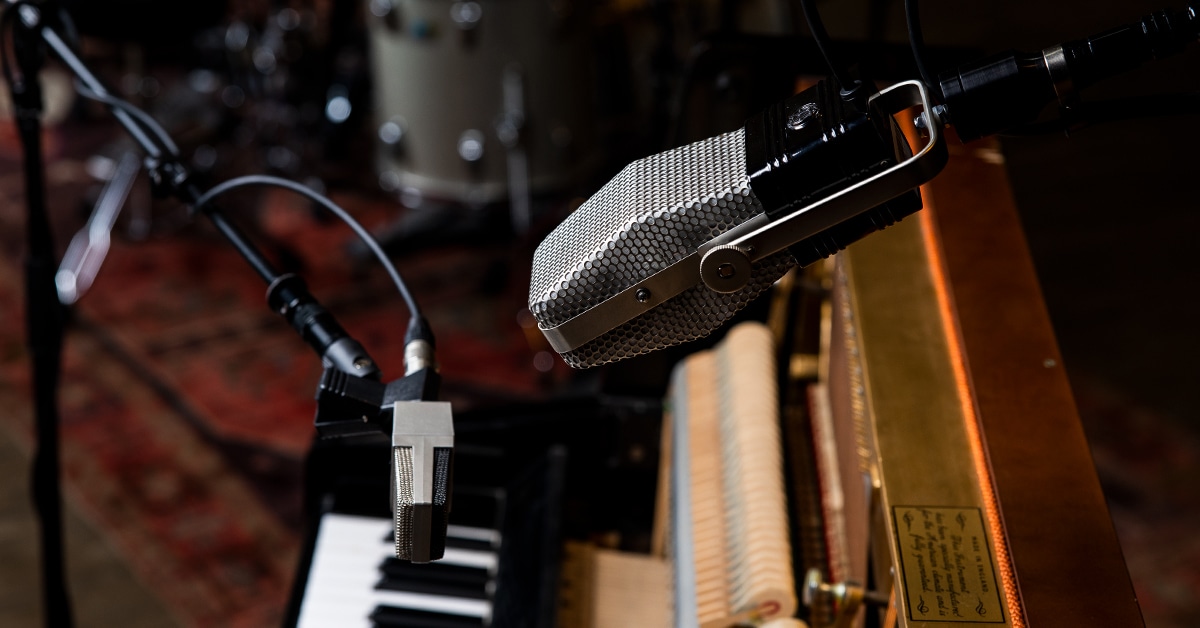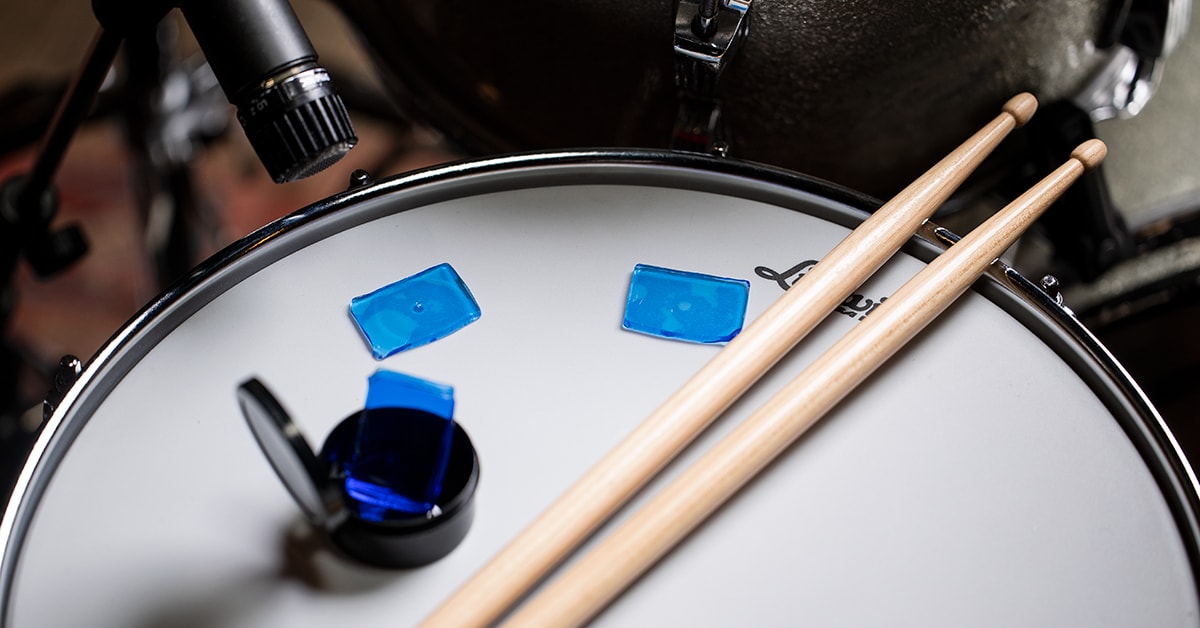Few things drive a track to the pinnacles of awesome more than a deep, snappy and propulsive snare sound. When fortune shines on you, gifting your kit with a truly spectacular snare tone that cuts musically through a band mix, it’s like winning the lottery, getting an upgrade to first-class on a flight and being invited to a private, all-expenses-paid vacation on Richard Branson’s Necker Island all rolled into one.
This is why proven tone sovereigns, such as the Ludwig Black Beauty and Supraphonic, Slingerland Radio King and Rogers Dyna-Sonic, are so revered by drummers. In addition, talented, creative and/or eccentric engineers have built entire careers on their proven ability to deliver hitmaking and/or extremely unique snare sounds.
Strange then, that when drummers achieve the pinnacle of an extraordinary snare tone, they sometimes want more. Perhaps a song requires more or less thud or attack to match the impassioned performance of the vocalist. Or maybe a barrage of guitar textures necessitates a little more of a crack to beat back the sonic blockade. Maybe—horrors—they get bored with perfection and want to explore something different.
Whatever the reason for changing up a snare sound, the coolest mods are arguably the ones that can be achieved quickly. No fuss, no hours of experimentation and adjustment—just spontaneous inspiration and a few minutes of setting up a fresh tone. Here are some suggestions for near-instant snare transformations. Have fun.
Table of Contents
Drum-Dampening Devices
Replace Snare Heads
Change Snare Wire
Try a Percussion Attachment
Quick Tuning Tips
Snare Fixes for Free
Upend the Conventional
Drum-Dampening Devices
A fair amount of drummers dig interesting snare overtones to create attention-grabbing tones. However, too much of a good thing can be distracting, musically distasteful or simply too weird. Drum-dampening products provide a quick fix that can be done almost imperceptibly on the bandstand or between takes in the studio. One of the hippest options is RTOM Moongels. Moongels come in a handy carrying case filled with six dampers. These mini marvels can be instantly plopped down on a snare head, and rapidly moved around to find the best position to reduce the ring. (They also work great on rack- and floor-tom heads.) They peel right off without damaging the head and can be reused whenever the need arises again.

Pictured: The Original Big Fat Snare Drum
A bit more overtone control can be generated with drum head rings, such as Aquarian Studio Rings, or the Big Fat Snare Drum The Original Big Fat Snare Drum. These rings come in various sizes to fit within the rims of different snares and toms. You simply place them atop the snare head to achieve less ring and slightly reduced volume without significantly choking out the snare’s resonance and attack. Like Moongels, Studio Rings and The Original Big Fat Snare Drum are pretty much instantaneous fixes for less-than-wonderful drum overtones. Some drummers add to the muffling—as well as secure the ring to the snare if they are wild and aggressive bashers—by affixing duct tape to the ring and drum head. If more sound shaping is needed, either a Studio Ring or The Original Big Fat Snare Drum and a Moongel can make an excellent dynamic duo to attack the sonic problem.
Replace Snare Heads
Okay. Replacing a snare head isn’t an “instant” fix. You obviously have to unscrew the tension rods, remove the current head, put on the new head, screw down the tension rods and then start tuning the replacement head to taste. But many drummers can manage the head swap in just a few minutes, and the reward is a fresh, new tone on a snare you already love. There are tons of drum head manufacturers out there who produce scores of heads to accommodate different playing styles, musical genres, recording applications and sounds. Don’t be afraid to try a number of heads until you find your favorite snare tone, and make sure you have a supply of variations on hand to change it up from time to time.
A good start is a Remo Ambassador Coated Head—a popular choice used by drummers such as Steve Gadd, Dave Weckl and Stewart Copeland. Typically, Ambassador Coated heads are great options for any genre, producing a warm and open resonance, topped with an articulate attack and a nice yet musically restrained sustain. They also tend to deliver a pleasant ring.

Pictured: Remo Ambassador Coated Head
If you’re looking for a drier, less-ringy tone, try an Evans Genera HD Dry Batter Coated Snare Head. Much like a ported speaker cabinet, Genera HD Dry Batter heads use an ingenious system of drilled vents at the edges of the head to manage overtones and sustain. The two-ply, coated head—with an integrated control ring—produces moderate attack and sustain, as well as a balanced tone between dark and bright.
Change Snare Wire
Changing your snare wire isn’t an instant operation, either, but it can be quick, and, believe it or not, this relatively small adjustment can produce a seismic impact on snare tone. Conventional snare wires offer from 16 to 20 strands and beyond. The rule of thumb is that more strands produce a fat, deep and rich attack, and fewer strands deliver more responsive, swifter and articulate strikes.
If you’re the type who enjoys deep dives, Andy Doerschuk of Drum! once interviewed Puresound Percussion’s snare-wire specialist Yoav DeBasc, who discovered that 16 strands produce an equal amount of snare and drum shell sound, while 20 strands increase the snare sound over that of the drum shell.

Pictured: Puresound Custom Series 20 Strand Snare Wire
“These general guidelines allow you to manipulate the sound of your snare drum,” wrote Doerschuk. “For example, if your 14x6.5” wood shell snare doesn’t respond with its current set of snare wires, by using a 20- or 24-strand snare, you can increase the snare sound.”
DeBasc added that the material of the snare wire also contributes to the tone.
“Standard wire has a crisp, fast attack,” said DeBasc, “while high-grade steel-alloy snare wire with some carbon content will be more papery sounding and sensitive.”
If you find your snare losing some drive and attack, try changing over to Puresound Custom Series 20-Strand Snare Wire. These medium-gauge, steel-alloy strands are designed to enhance projection, sensitivity and articulation—which might be just the tonal characteristics you need to propel the groove like the anticipated Mach 1.7 commercial supersonic jet, Overture.
Try a Percussion Attachment
Yes, snares can multitask. Occasionally, a manufacturer will come up with some wack, but useful add-on to expand the sound of a snare drum. The Big Fat Snare Drum Snare-Bourine is one of those groovy gadgets. The Snare-Bourine drops right on top of your snare head and does two things to change your snare sound. First, it lowers the pitch of the snare to instantly produce a deeper thud and attack. Then, you get the added benefit of tambourine jangles ringing out with each snare hit. It’s almost like “back to the ’70s,” except the resonant, chiming attack is an awesome way to drive any style of music.

Pictured: Big Fat Snare Drum Snare-Bourine 14 in.
Quick Tuning Tips
Usually, when a drummer sees something about “quick tone transformations,” the last thing they want to think about is tuning drums. Like spinning through countless YouTube videos, grabbing a drum key to start retuning a snare can “Slip ’N Slide” you down a psychedelic rabbit hole of adjusting batter and resonant heads, while also ensuring the tone of the toms isn’t causing sympathetic vibrations in the retuned snare that trigger snare-wire buzz and rattle. Whew.
However, there is a time-honored little trick that can modify a snare sound by targeting a single tension rod. All you need to do is select a tension rod—usually it’s the one closest to your sitting position—and loosen it until it’s practically wobbling in the lug casting. If the stars align, you should notice a slightly deeper tone, diminished ring and a warmer attack.
Snare Fixes for Free
If you’re a fan of found-sound composers such as John Cage and Erik Satie, you’ll be thrilled to explore the notion of random free objects adding vibe and interest to your snare tone. For example, you can muffle snare overtones by simply tossing your wallet onto the drum head. Whichever drummer first did this trick is likely lost to history, but it does work. Instantly. The sweet spot is usually at the top of the snare drum, but there’s nothing stopping you from trying other positions as well.
Expanding on the concept, you can throw almost anything percussion-like atop the snare head and create a weird and wonderful sound. Drummers have used everyday elements such as a set of keys, marbles, popcorn kernels, tiny bearings, toy jingle bells, necklaces, bracelets, coins and the list goes on. Whatever sparks your imagination has the chance of creating a novel snare sound. But beware—if you get lost in the process of experimentation, this tip can flip-flop from “instant” to “never-ending.”
Silly Snare Mods
Admittedly, taking a madcap approach to snare sound pays off rather infrequently. Usually, the ideas are so bizarre that songwriters, producers, engineers and other musicians will question your sanity before loudly tanking the suggestion entirely. They may also accuse you of attempting to make a track unlistenable, simply because you have a passion for exploring the unconventional.
But be courageous. Sometimes, a quirky snare sound can transform a dreary groove into a strange and exciting track.
Hi-Hat Topper
San Francisco Bay Area drummer, songwriter and producer Scott Mathews (Beach Boys, The Tubes, Barbra Streisand, Todd Rundgren) is one of those recording professionals who always seeks unique sounds to surprise and captivate listeners. His snare mods are pretty out there, but they can be prepped and evaluated rather quickly to see if they are brilliant or bonkers. At times, Mathews will drop a single 14" hi-hat cymbal on top of the snare’s batter head. Many snare drums are 14" in diameter, so the cymbal usually fits nicely within the snare’s rim. Not surprisingly, this trick imparts a dry, metallic clang to each snare hit. The “cymbal snare” may only work on one song out of 1,000, but it’s a real ear catcher when used on the right track. Feel free to experiment further with small crash cymbals, Chinas, splashes and other options.
Gaffer-Taped Tambourine
If you own a near-indestructible tambourine, this trick might be for you. (Keep in mind that any toy-like tambourine will be smashed to bits by your drum sticks). Gaffer tape the tambourine to the middle or upper part of the snare drum. What you get is a rude, cheap hack of the Big Fat Snare Drum Snare-Bourine. The snare tone will be lowered somewhat, and overtones and ring will be diminished—depending on how much gaffer tape you use to secure the tambourine to the drum. You’ll also get a quick-decaying jangle from the mounted tambourine.
Bubble Pack
Want to add a touch of randomness to your snare sound? Pull out that gaffer tape again, find some bubble wrap (any size bubbles will do), cut a sheet that fits over your snare and secure it with the tape. You’ll be lucky if this sonic trick lasts through one short song, but it’s amusing, quirky and surprising to hear random pops as your stick hits the bubble wrap just right. For more fun, don’t tell the live sound person or recording engineer what you’re doing. They’ll be searching their entire signal chain to trace down those random pops and crackles. Added tip: It’s a good practice to have a beer, cola or other beverage ready to calm them down once they discover you’re the culprit.
Upend the Conventional
Experimenting with sounds should be an entertaining—perhaps even thrilling—exercise in musical growth and spontaneous inspiration. Why should guitar players, for example, have all the fun messing around with myriad effects pedals and other processors? With just a spark of imagination, drummers can dive into the strange and (hopefully) delight listeners with uncommon snare sounds that either enhance the feel of a groove or take it somewhere beyond the known galaxy.

Pictured: Roland SPD-SX PRO Sampling Pad
Furthermore, if these tips have brought out the iconoclast in you, a more electronic adventure may be in your future. A device such as the Roland SPD-SX PRO Sampling Pad opens up a massive amount of sonic excursions, from bizarre samples you can create yourself, to dense and mysterious textures of stacked sounds, to savvy utilization of onboard percussion presets.
But whether you add a sampling pad to your rig, or simply drop a wallet onto a snare, seeking to expand your tone crafting beyond the predictable should pay off with giving you a heightened sense of the possible. Once you’re creatively unbound, the effect on your composing, your audio productions and pretty much everything in your musical life becomes an epic adventure. Go forth and create…










